List of the mayors of St. Pölten
This list gives an overview of the mayors of the city of St. Pölten and their districts before they were incorporated.
The first mayor was put into office in 1785 by a court decree from Joseph II . The fate of the city of St. Pölten was directed by a five-person magistrate , which consisted of the mayor , a syndic and three magistrates. By merging the monastery district with the rest of the city in 1848, St. Pölten became a political municipality, the first elected mayor of which was August Hassack. It was around this time that the first mayors were elected in today's districts.
Since the first free elections in 1919 , the Social Democratic Party of Austria (SPÖ) or its predecessor has won every election, and in municipal elections since 1945 they have mostly received over 50% of the votes.
Legend
- No .: The mayor's serial number (for example, 31st means that Matthias Stadler is the 31st mayor)
- Name or name (life data): The name, for St .. Pölten name, date of birth and death of the mayor
- from: The year in which the term of office began
- until: The year in which the term of office ended
- Party: The party to which the mayor belonged
- Notes: Additional information on the mayor
- Image: A picture of the mayor
St. Polten
| No. | Name (life data) | from | to | Political party | Remarks | image |
|---|---|---|---|---|---|---|
| Empire of Austria | ||||||
| 01. |
Johann Joseph Hackl (May 16, 1716 - October 4, 1791) |
1785 | 1789 | Sometimes also called "Häckl" or "Häckhl". Before his election, the first mayor of St. Pölten was a painter, grocer , beer keeper and cheese maker . Häckl was best known for his pictures of St. Pölten parishes and properties of the St. Pölten Abbey , which were enclosed with the manuscripts of Aquilin Hacker . After a term of office without any special incidents, he resigned from office, probably for reasons of age. | ||
| 2. |
Johann Peter Ignaz Canon (June 1, 1734 - September 1, 1814) |
1789 | 1794 | He practiced the profession of master glazier . In 1770 he was elected to the external council and five years later to the internal council . After he was administrator of the citizen's hospital, he became city quartermaster and was thus responsible for the billeting of military personnel. From 1785 he was a magistrate responsible for auditing the city treasurer's accounts. After five years in office, he resigned for unknown reasons. | ||
| 3. |
Franz Xaver Schöpfer (May 23, 1754 - March 29, 1828) |
1794 | 1828 | The city's longest serving mayor. He was a gingerbread man , wax trader and farmer. In 1792 he became a magistrate, two years later mayor. During his 34-year tenure, the city was occupied twice by French troops . He died in office. |

|
|
| 4th |
Matthias Klaus (June 1, 1758 - August 27, 1833) |
1828 | 1833 | The trained dyer came to St. Pölten as a traveling journeyman, where he married a dyer widow in 1787 and thus started a business. In 1798 he was elected to the Magistrate Council, which he was until his appointment as mayor. He died after five years in office. |
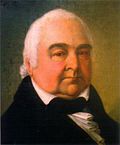
|
|
| 5. |
Alois Mayrhofer (October 9, 1764 - December 30, 1842) |
1833 | 1842 | The son of a shoemaker was married to the owner of a paper mill in Wagram , which he soon sold and from then on lived on his fortune. In 1816 he was elected to the Magistrate Council, which he was until his appointment as mayor. He died after nine years in office. |

|
|
| 6th |
Johann Kranzbichler (around 1772 - December 18, 1853) |
1842 | 1850 | From 1795 to 1799 he worked as a landlord in his parents' inn, but then concentrated on his wine trade. After he had passed this on to his son, he lived as a privateer. He was a magistrate from 1811 to 1816 and from 1820 to 1833, in 1848 he became a member of the Lower Austrian state parliament . After the provisional municipal law came into force in 1849, he abdicated, but remained in office until 1850. |

|
|
| 7th |
August Hassack (August 1, 1803 - January 12, 1859) |
1850 | 1859 | The son of a weaver worked as a pharmacist from 1832. After working in Ernstbrunn for a year , he acquired the “Zum Goldenen Löwen” pharmacy , which his son continued to run. During his time as mayor, the city walls were razed, the Westbahn and with it the main train station built. The promenade was built on the site of the city wall, and the stones were used to build the first sewer system. Depending on the source, he resigned from office in December 1858 due to illness or died in office. |
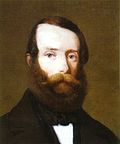
|
|
| 8th. |
Ludwig Steiner (1792 - November 20, 1869) |
1859 | 1865 | liberal | Steiner came to the city as an official of the St. Pölten State Estate , the administrative body of the former St. Pölten Abbey . There he was promoted to administrator until he was taken over by the city. From 1855 to 1867 he was director of the Sparkasse , from 1861 to 1869 he was also a member of the Lower Austrian state parliament . From 1850 he was a member of the community committee, from which he was elected mayor after Hassack's death. After his resignation he remained first councilor until his death , which was to be equated with the vice mayor. |

|
| 9. |
Franz Utsch von Gillenbach (1804 - June 16, 1877) |
1865 | 1870 | Until 1835, Utsch was a soldier in the Imperial and Royal Infantry Regiment Hoch- und Deutschmeister No. 4 . After he quit his job, he moved to St. Pölten to take over a "tobacco district publisher". From 1840 to 1848 he was captain of the uniformed citizen corps, then commander in chief of the St. Pölten National Guard. As a co-founder of the Sparkasse , he was a member of its board. In 1850 he was elected to the community committee. For his work in the war year 1866 he was honored with the gold medal of merit with crown. He had to give up the mayor's office like his other offices because of an eye disease. |
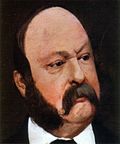
|
|
| 10. |
Johann Ofner (November 6, 1816 - July 16, 1887) |
1870 | 1882 | Progress party | Born in Tyrol from Nauders , he became a lawyer in St. Pölten in 1848 . He too was one of the founders of the savings banks . He was elected to the local council in 1850, where he remained until he was appointed mayor. From 1861 to 1887 he was also a member of the Lower Austrian state parliament and from 1861 to 1867 and 1873 to 1887 a member of the Reichsrat . The reason for his resignation were attacks from his own party, especially by Karl Heitzler . |

|
| 11. |
Josef Kleinhaipl (January 8, 1816 - January 22, 1905) |
1882 | 1888 | Born in Niederneukirchen in Upper Austria as the son of a surgeon , he wanted to take up his father's profession and began studying medicine in 1831, which he broke off in 1835. He married in 1839 into a St. Pölten family. In 1861 Kleinhaipl was a member of the local council , from 1879 he was the first local councilor , which corresponded to the deputy mayor. |

|
|
| 12. |
Josef Fröstl (January 26, 1839 - March 8, 1900) |
1888 | 1892 | liberal | The farmer's son was to become a priest according to his parents' wishes. After several years in boarding school , however, he moved to the University of Vienna and studied Jus , after which he located in St. oiled as a lawyer settled. Fröstl had only been part of the municipal council since 1885 when he was surprisingly elected mayor. This was probably due to his popularity among the population and his promise to reorganize the municipal administration. In 1890 he was appointed to the Lower Austrian state parliament. He resigned from his mayor's office due to illness. |

|
| 13. |
Hermann Ofner (October 27, 1849 - May 15, 1917) |
1892 | 1898 | liberal | The son of the 10th mayor Johann Ofner took over after his Jus -Studies at the University of Vienna in 1884, the law firm of his father. After he was narrowly beaten by Gottfried Jax in the election to the Reichsrat , he was elected to the municipal council in 1882 , and from 1888 he was municipal councilor for construction. After his election as mayor, he was particularly committed to the structural development of the city. During his tenure, the St. Pölten Hospital and the Kaltbad were built, the town hall and the city theater were rebuilt, the promenade was designed and new streets were opened up. These projects put such a strain on the city's treasury that, despite the approval of all municipal council parties, a state committee controlled the city's finances. When this was extended, Ofner resigned from the mayor's office in 1898, but was again chairman of the building section. |
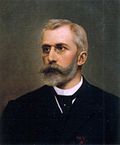
|
| 14th |
Eugen Freiherr von Aichelburg (June 24, 1852 - March 7, 1917) |
1898 | 1898 | independent | The Vienna studied Jus and came in 1881 to St. Pölten to work his father in the notary; In 1885 he became a notary . In 1894 he was elected to the local council without belonging to any party. He was elected mayor, apparently as a compromise candidate. As soon as he was appointed, he announced his resignation if financial control of the city by the state committee was not to be lifted. Since this did not happen, he resigned after 42 days, but remained on the parish council. |

|
| 15th |
Franz Ertl (December 9, 1839 - March 23, 1906) |
1898 | 1900 | Born in St. Pöltner, he learned the trade. From 1870 to 1906 he was a member of the local council, from 1888 until his election he was also the first local councilor (vice mayor). Between 1889 and 1895 he held the office of administrator of the hospital . The political struggles of the time contradicted him, so that he was not ready for another election. |
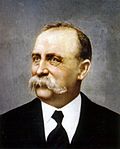
|
|
| 16. |
Wilhelm Voelkl (August 9, 1862 - September 10, 1912) |
1900 | 1905 | DnP | The St. Pöltner studied in Vienna and Prague , but without attaining a degree. However, he was successful as the owner of two replacement coffee factories . In 1894 he was elected to the municipal council, one year after his election as mayor he was also a member of the Reichsrat . His bitterest opponent both in the municipal council and in the Reichsrat was Johann Wohlmeyer . In 1903 he succeeded in abolishing the community committee and having Voelkl dismissed; a government commissioner carried out the official business. With a triumphant election victory Voelkl finally returned to the mayor's office in 1904. Due to a mental illness, he resigned as mayor and moved to Vienna, but remained in the Reichsrat. During his tenure, electrical power was introduced and Glanzstoff Austria , Voith and the central workshop of the Reichsbahnen were established. |

|
| 17th |
Edmund Huegel (December 2, 1841 - December 10, 1908) |
1905 | 1908 | DnP | Born in Berlin, he attended secondary school in Vienna and a preparatory course at the Academy of Fine Arts. Although he wanted to become a painter, his professional life began in 1866 with the Empress Elisabeth Railway . In 1873 he bought the hotel "Zur Kaiserin von Österreich" in St. Pölten's Kremsergasse. From 1888 he was a member of the municipal council, from 1898 he was vice mayor. Just two years after his election as mayor, he had to hand over the official duties to his deputy due to serious illness, but his term of office officially lasted until the additional election. |
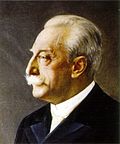
|
| 18th |
Otto Eybner (February 6, 1856 - February 23, 1917) |
1908 | 1917 | DFP | The St. Pöltner attended high school in his hometown. He then trained as a businessman in Vienna. In 1878 he took part in the occupation of Bosnia-Herzegovina as a lieutenant in a Hungarian infantry regiment , after his return he took over his father's iron and coal business. In 1885 he was sent to the municipal council of St. Pölten, in 1905 he became vice mayor, and the following year he took over the post of mayor of the city, which he held until his death on February 23, 1917. Eybner's son was the chamber actor Richard Eybner . |
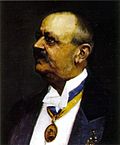
|
| (14.) |
Eugen Freiherr von Aichelburg (June 24, 1852 - March 7, 1917) |
1917 | 1917 | independent | After Otto Eybner's death, the 14th mayor took over the post of mayor again for a short time until his own death. |

|
| 19th |
Karl Heitzler (May 7, 1839 - May 2, 1923) |
1917 | 1919 | DFP | After Jus -Studies at the University of Vienna , he joined the law firm of Johann Ofner and founded in 1870 his own office, his former employer became mayor, and was in the council selected. There he applied for the establishment of the city museum , the renovation of the city theater and the establishment of some schools. After the death of mayors Otto Eybner and Eugen Freiherr von Aichelburg in 1917, he took over the office of mayor as the longest serving councilor until the new election in 1919. Heitzler was also an important coin collector and worked as a painter and writer. |

|
| No. | Name (life data) | from | to | Political party | Remarks | image |
| First republic | ||||||
| 20th |
Hubert Schnofl (October 5, 1868 - December 10, 1936) |
1919 | 1933 | SDAPDÖ | Born in Radkersburg (Styria), the locksmith wandered through Germany as a journeyman from 1888 to 1890. After completing his military service, he became a train driver, during which time he began to get involved in politics. In 1910 Schnofl became secretary of the St. Pölten Metalworkers' Association. After the First World War , Schnofl was the top candidate for the socialists and won the election for mayor in 1919 . During his tenure as mayor, St. Pölten was elevated to a statutory status and a number of surrounding communities were incorporated at the same time . One of his greatest concerns was residential construction: by the time he left office, he had almost 1,400 apartments built in the city. Hubert Schnofl was a member of the Lower Austrian state parliament from 1921 to 1932 and at times its second president, and he was also a member of the Federal Council from 1920 to 1926. |

|
| 21st |
Stephan Buger (October 12, 1877 - August 31, 1951) |
1933 | 1934 | SDAPÖ | Born in Esseg (Croatia), he learned the bookbinding trade . During his time as a journeyman, he first came to Vienna before moving to St. Pölten in 1900, where he settled down as a master bookbinder. Buger became a city councilor in 1919 and remained so until his election as mayor. Due to an ordinance issued by the Province of Lower Austria, he was relieved of his office in February 1934. After his dismissal, he withdrew from politics and died in St. Pölten in 1951. | |
| Corporate state | ||||||
| 22nd |
Heinrich Raab (November 3, 1893 - December 21, 1969) |
1934 | 1938 | VF | The St. Pöltner was the brother of the future Chancellor Julius Raab . He studied German and history in Vienna. During the First World War he was a volunteer. He was a German teacher at the Stiftsgymnasium Mehrerau (Vorarlberg) and in 1921 switched to the teacher training institute in St. Pölten , where he worked until he went into exile. He then taught for ten years at the Cantonal High School in Altdorf (Switzerland) before becoming a culture and press attaché at the Austrian embassy in Bern . After Buger had been deposed, he was acting municipal administrator and was later elected mayor by the municipal council. After the annexation of Austria , Raab lost all functions, was banned from working and was briefly imprisoned. He then left the country and stayed in Altdorf until his death. | |
| German Empire | ||||||
| 23. |
Franz Hörhann (March 30, 1895 - March 16, 1974) |
1938 | 1938 | NSDAP | The iron founder was appointed mayor of the NSDAP on March 15, 1938 and held this office until August 20 of that year. Then he became a functionary of the German Labor Front and district chairman of Kraft durch Freude . | |
| 24. |
Emmo Langer (January 29, 1891 - November 2, 1949) |
1938 | 1945 | NSDAP | After attending the Krems Teachers' Training College, he volunteered in 1915. He received the silver medal for bravery twice and resigned as a first lieutenant . In 1924 he became a teacher in St. Pölten, from 1929 he was a supporter of the Hitler movement, in 1930 he became district leader for the district above the Vienna Woods . From May 1932 to June 1933 he was a member of the Lower Austrian state parliament . He was detained for a few days in July 1933 and retired in August of the same year. After the annexation of Austria he was reactivated, a member of the state government and mayor of St. Pölten. The city commander of the Red Army deposed him after the Second World War . His official title was "Lord Mayor". | |
| No. | Name (life data) | from | to | Political party | Remarks | image |
| Second republic | ||||||
| 25th |
Günther Benedikt (May 2, 1921 - April 21, 1948) |
1945 | 1945 | independent | The son of an iron merchant and a Jewish actress was baptized, but as the son of a Jewish woman, he was not drafted into the Wehrmacht . He became mayor at the behest of the Commander of the Red Army. In his short time as mayor, St. Pölten was a frontline area until the surrender of the Third Reich on May 8th. After a month, at the will of the new city commandant, he passed the office on to Franz Käfer. | |
| 26th |
Franz Käfer (September 22, 1891 - September 22, 1962) |
1945 | 1950 | KPÖ | The Herzogenburger stoker worked from 1921 to 1934 in the luster factory in St. Pölten and in 1927 became a councilor for the SDAPDÖ in St. Pölten, which he remained until the SDAPÖ was dissolved in 1934. Käfer was the commandant of the Republican Schutzbund for the Wagram Department , which is why he was arrested after the Austrian Civil War and had to serve a ten-month prison sentence for high treason. He joined the banned KPÖ in 1935 and worked again in the gloss fabric factory, but did not join the NSDAP . That is why he was imprisoned in the Buchenwald concentration camp on September 1, 1939 and remained there until 1942. With the occupation of St. Pölten in 1945, the KPÖ became legal again, and Käfer was in charge of setting up an auxiliary police force. He was appointed mayor by the city commander of the Red Army. In December of the same year he resigned from office to enable a new formation based on the previous election. Wilhelm Steingötter won this with the SPÖ. However, this resignation was not accepted by the occupying power and both he and all municipal councilors remained in office. Only after the municipal council election in 1950 did he hand over the office to his successor. | |
| 27. |
Wilhelm Steingötter (November 19, 1886 - November 30, 1966) |
1950 | 1960 | SPÖ | He studied shortly Jus before the medical school graduated 1912th In 1917 he joined the Austro-Hungarian Army as a military doctor and was then a medical officer in the armed forces . Steingötter came into politics through Hubert Schnofl . He was elected to the local council in 1919, in 1927 he became a city councilor and took over the "medical department" until 1934 the Social Democratic Labor Party was banned. Then he worked for the Austrian Red Cross . In 1945 he was elected to the Lower Austrian state parliament, to which he was a member until 1959. Although Steingötter won the election as the top candidate of the SPÖ in 1945, the Soviet commander-in-chief appointed KPÖ member Franz Käfer as mayor, Steingötter became deputy mayor. Only after the municipal council election in 1950 was he able to take the post of mayor, which he held until his resignation. | |
| 28. |
Rudolf Singer (May 30, 1907 - April 3, 1979) |
1960 | 1970 | SPÖ | The elevator fitter, who was born in Vienna, joined the SDAPDÖ in 1924 and became a youth functionary in a hometown. As a member of the banned socialists, he was briefly arrested in 1934 at the Wöllersdorf detention center . After the Second World War , Singer was sent to St. Pölten as party secretary to rebuild the party structures. In 1949 he was elected to the National Council, of which he was a member until 1960. He was then a member of the Federal Council until 1970 . During his tenure, the indoor swimming pool was built and Europaplatz was redesigned. Internal party criticism led to his resignation in 1970. | |
| 29 |
Hans Schickelgruber (June 14, 1922 - December 24, 2003) |
1970 | 1985 | SPÖ | After graduating from high school , he was called up for labor service in the German armed forces. Seriously wounded, he returned from captivity and decided on a teaching profession, which he learned at the federal teacher training institute in St. Pölten. After his time at Harland Secondary School in 1965, he was appointed District School Inspector. In 1956 he became a local councilor and two years later a councilor for education, culture, social affairs and health . Between 1972 and 1983 he took a seat in the Federal Council . He resigned from his functions due to age. | |
| 30th |
Willi Gruber (September 6, 1930 - September 7, 2012) |
1985 | 2004 | SPÖ | The trained machine fitter became a pension advisor at the pension insurance company in 1960 . As early as 1958 he was elected to the local council, from 1970 until his election as mayor he was councilor for construction. In 1986, during his term of office, St. Pölten was appointed state capital of Lower Austria . He was the longest serving mayor in the post-war period. |

|
| 31. |
Matthias Stadler (born February 9, 1966) |
2004 | SPÖ | The St. Pölten studied German philology, history and social studies. In 1992 he started working for the St. Pölten Magistrate. There he was Deputy Head of the Municipal Department for Public Relations, International Contacts and Tourism . In 1998 he became an authorized signatory of the “Society for the Implementation of University of Applied Sciences St. Pölten mbH”, the holding company of the St. Pölten University of Applied Sciences , of which he took over in 2002. In June 2003, Stadler was elected to the local council of St. Pölten and at the same time became city councilor for school, cultural and youth affairs until he was appointed mayor. |

|
|
Districts
Pottenbrunn
Mayor of the municipality of Pottenbrunn .
| No. | Surname | from | to | Political party | Remarks | image |
|---|---|---|---|---|---|---|
| Empire of Austria | ||||||
| 1. | Josef Seidl | 1850 | 1856 | Innkeeper to the "Black Eagle" in Pottenbrunn No. 77 | ||
| 2. | Georg Huber | 1856 | 1860 | Master blacksmith in Pottenbrunn No. 11 | ||
| 3. | Johann Hubbauer | 1860 | 1864 | Farmer in Pottenbrunn No. 80 | ||
| 4th | Josef Adl | 1864 | 1870 | Master miller in Pottenbrunn No. 60 |

|
|
| 5. | Anton Schön | 1870 | 1894 | Blacksmith master in Pottenbrunn No. 69 |

|
|
| 6th | Karl Kreimel | 1894 | 1918 | Farmer in Pottenbrunn No. 43 |

|
|
| First republic and corporate state | ||||||
| 7th | Franz Fahringer | 1918 | 1921 | Farmer in Pottenbrunn No. 79 |

|
|
| 8th. | Anton Hinterwallner | 1921 | 1938 | Farmer in Pottenbrunn No. 15 |

|
|
| German Empire | ||||||
| 9. | Heinrich digit | 1938 | 1941 | NSDAP | ||
| 10. | Alois Schania | 1941 | 1945 | NSDAP | ||
| Second republic | ||||||
| 11. | Franz Westermayer | 1945 | 1947 | |||
| 12. | Ferdinand Schafranek | 1947 | 1949 | |||
| 13. | Karl Wegscheider | 1949 | 1960 | |||
| 14th | Rudolf Grübl (1921–19 August 2015) |
1960 | 1972 | SPÖ | ÖBB official | |
| January 1, 1972: The Pottenbrunn community was incorporated into St. Pölten | ||||||
Radlberg
In 1850 the municipality of Radlberg consisted of the cadastral municipalities of Ober- and Unterradlberg.
| No. | Surname | from | to | Political party | Remarks | image |
|---|---|---|---|---|---|---|
| Empire of Austria | ||||||
| 1. | Franz Stummer | 1850 | ||||
| Michael Detter | 1865 | 1875 | ||||
| Johann Meixner | 1875 | 1880 | ||||
| Johann Burger | 1880 | 1886 | ||||
| Karl Baumberger | 1886 | 1892 | ||||
| Johann Burger | 1892 | 1894 | ||||
| Karl Baumberger | 1894 | 1901 | ||||
| Franz Stoiber | 1901 | 1902 | ||||
| Josef Hörhann | 1902 | 1907 | ||||
| Karl Kraft | 1907 | 1919 |

|
|||
| First republic | ||||||
| Josef Neubauer | 1919 | 1921 | DWP | |||
| Josef Schiedlbauer | 1921 | 1928 | SDAPDÖ | |||
| Josef Mondl | 1928 | 1938 | List Mondl | Former SDAPDÖ member, entered with his own list | ||
| German Empire | ||||||
| Josef Bandion | 1938 | 1939 | NSDAP | |||
| 1939: The Radlberg community was incorporated into St. Pölten | ||||||
Ratzersdorf
In 1850, the community of Ratzersdorf consisted of the cadastral communities of Ober-Ratzersdorf, Ober-Zwischenbrunn, Unter-Ratzersdorf and Unter-Zwischenbrunn.
| No. | Surname | from | to | Political party | Remarks | image |
|---|---|---|---|---|---|---|
| Empire of Austria | ||||||
| 1. | Anton Hintermayer | 1850 | 1888 | Farmer in Ober-Ratzersdorf No. 8, before 1850 a village judge |

|
|
| 2. | Matthias Steinhauser | 1888 | 1891 | Farmer and landlord in Ober-Ratzersdorf No. 3 |

|
|
| 3. | Josef Gradinger | 1891 | 1894 | Farmer in Unter-Ratzersdorf No. 17 |

|
|
| 4th | Johann Buchinger | 1894 | 1903 | Farmer in Ober-Ratzersdorf No. 13 |

|
|
| 5. | Albert Resch | 1903 | 1906 | Farmer in Ober-Zwischenbrunn No. 15 |

|
|
| 6th | Josef Heiss | 1906 | 1919 | Farmer in Ober-Zwischenbrunn No. 6 |

|
|
| First republic and corporate state | ||||||
| 7th | Ludwig paper | 1919 | 1924 | Farmer in Unter-Ratzersdorf No. 25 |

|
|
| 8th. | Anton Stummer | 1924 | Farmer and post office clerk in Unter-Ratzersdorf No. 9 |

|
||
| 1939: The community of Ratzersdorf was incorporated into St. Pölten | ||||||
| 1955: Ratzersdorf became an independent municipality again | ||||||
| January 1, 1972: The community of Ratzersdorf was incorporated into St. Pölten | ||||||
Spatter
In 1850 the municipality Spratzern consisted of the cadastral municipalities Teufelhof, Pummersdorf, Nadelbach, Hafing, Schwadorf and Spratzern.
| No. | Surname | from | to | Political party | Remarks | image |
|---|---|---|---|---|---|---|
| Empire of Austria | ||||||
| 1. | Anton Maurer | 1850 | 1863 | |||
| 2. | Josef Hirner | 1863 | 1873 | Farmer from Schwadorf | ||
| 3. | Franz Zichtl | 1873 | 1891 | Farmer from Pummersdorf | ||
| 4th | Josef Straßmeyer | 1891 | 1913 | Farmer from Nadlbach | ||
| 5. | Anton Huber | 1913 | 1919 | Farmer from Hafing | ||
| First republic | ||||||
| 6th | Johann Wenninger | 1919 | 1920 | Innkeeper from Spratzern | ||
| 7th | Karl Kappelmüller | 1920 | 1921 | Federal Railroader | ||
| 8th. | Otto Antosch | 1921 | 1922 | employee | ||
| 1922: The Spratzern community was incorporated into St. Pölten | ||||||
St. Georgen and Ochsenburg
In 1850, the community of St. Georgen consisted of today's St. Georgen, Ochsenburg and the cadastral community of Völtendorf.
| No. | Surname | from | to | Political party | Remarks | image |
|---|---|---|---|---|---|---|
| Empire of Austria | ||||||
| 1. | Ferdinand Wurm | 1850 | 1870 | Master carpenter from Mühlgang | ||
| 2. | Alois Fink | 1870 | 1879 | Chandler from St. Georgen |

|
|
| 3. | Franz Rausch | 1879 | 1882 | Farmer from Wetzersdorf | ||
| 4th | Alois Fink | 1882 | 1885 | Chandler from St. Georgen |

|
|
| 5. | Karl Kern | 1885 | 1891 | Farmer from Wetzersdorf | ||
| 6th | Josef Kletschka | 1891 | 1912 | Hafner from Mühlgang | ||
| 7th | Franz Fink | 1912 | 1919 | Farmer from St. Georgen | ||
| First republic | ||||||
| 8th. | Anton Herzog | 1919 | 1936 | LB | Farmer | |
| Corporate state | ||||||
| 9. | Karl Kern | 1936 | 1938 | Farmer from Hart | ||
| German Empire | ||||||
| 1938: The KG Völtendorf was incorporated into St. Pölten | ||||||
| 10. | Friedrich Resch | 1938 | 1945 | NSDAP | Basketwork manufacturer from St. Georgen | |
| Second republic | ||||||
| 11. | Johann Grabetz | 1945 | 1946 | Secretary from St. Georgen | ||
| 12. | Johann Trappl | 1946 | 1965 | SPÖ | railwayman | |
| 13. | Hilde Hahn | 1965 | 1972 | SPÖ | Community Secretary | |
| January 1, 1972: The community of St. Georgen was incorporated into St. Pölten | ||||||
Stattersdorf and Wagram
The municipality of Stattersdorf formed a municipality with today's Wagram and in 1850 consisted of Stattersdorf, Ober- and Unterwagram.
| No. | Surname | from | to | Political party | Remarks | image |
|---|---|---|---|---|---|---|
| Empire of Austria | ||||||
| 1. | Josef Ostermayer | 1850 | 1861 | Master binder from Stattersdorf | ||
| 2. | Josef Paminger | 1861 | 1876 | Citizen from Wagram | ||
| 3. | Johann Hinterhofer | 1876 | 1885 | Citizens from Stattersdorf | ||
| 4th | Josef Deix | 1885 | 1899 | Master miller from Wagram | ||
| 5. | Eduard Manderla | 1899 | 1905 | Citizen from Wagram | ||
| 6th | Carl Salzer | 1905 | 1909 | Paper manufacturer from Stattersdorf | ||
| 7th | Johann dirt | 1909 | 1918 | Master baker from Stattersdorf | ||
| First republic | ||||||
| 8th. | Josef Zwetzbacher | 1918 | 1919 | CS | Mill owner from Wagram | |
| 9. | Leopold Franzl | 1919 | 1923 | Official from Wagram | ||
| 1923: Wagram was incorporated into St. Pölten | ||||||
| 10. | Thomas Buchner | 1923 | 1927 | Accountant from Stattersdorf | ||
| 11. | Josef Wohlfahrter | 1927 | 1934 | Teacher from Stattersdorf | ||
| Corporate state | ||||||
| 12. | Josef Schuter | 1934 | 1938 | Railway workers from Stattersdorf | ||
| German Empire | ||||||
| 13. | Johann Hörhann | 1938 | 1939 | NSDAP | Electrician from Stattersdorf | |
| 1939: The municipality of Stattersdorf was incorporated into St. Pölten | ||||||
Viehofen
In 1848, the community of Viehofen consisted of the same cadastral communities as the current district.
| No. | Surname | from | to | Political party | Remarks | image |
|---|---|---|---|---|---|---|
| Empire of Austria | ||||||
| 1. | Gustav Lettner | 1848 | 1855 | from Viehofen | ||
| 2. | Anton Gruber | 1855 | 1867 | from Ragelsdorf | ||
| 3. | Ignaz Mrasek | 1867 | 1870 | from Viehofen | ||
| 4th | Josef Prisching | 1870 | 1873 | from further afield | ||
| 5. | Michael Gleiß | 1873 | 1879 | from further afield | ||
| 6th | Anton Baumgartner | 1879 | 1919 | from Viehofen |

|
|
| First republic | ||||||
| 7th | Josef Greiner | 1919 | 1922 | from Viehofen | ||
| 1922: The community of Viehofen was incorporated into St. Pölten | ||||||
Ragelsdorf existed as a community from 1923 to 1969 .
literature
- Manfred Wieninger : Telling St. Pöltner street names . Löwenzahn, Innsbruck 2002, ISBN 3-7066-2208-4 .
- Thomas Karl (Ed.): 500 years of the St. Pölten Town Hall. Magistrate of the state capital St. Pölten, St. Pölten 2003.
Individual evidence
- ↑ Karl Gutkas, 1970: St. Pölten - becoming and essence of an Austrian city , chapter Under the Signs of Josephinism and Biedermeier , pp. 41–45.
- ↑ a b c d e f g h i j Manfred Wieninger , 2002: St. Pöltner street names tell , ISBN 3-7066-2208-4 .
- ↑ a b c d e Magistrate of the state capital St. Pölten, 2003: 500 years town hall St. Pölten .
- ↑ State Parliament of Lower Austria on Ludwig Steiner (PDF; 5 kB)
- ↑ Lower Austrian Parliament on Johann Ofner (PDF; 5 kB)
- ↑ Lower Austria Parliament on Josef Fröstl (PDF; 5 kB)
- ↑ Lower Austrian Parliament on Hermann Ofner (PDF; 5 kB)
- ↑ a b c d Siegfried Nasko, 1986: rise of from dull dreams , Chapter St. Poelten - emancipation from the lawlessness , pp 11-63.
- ↑ Niederösterreichische Wirtschaft dated January 27, 2006, p. 54 ( page no longer available , search in web archives ) Info: The link was automatically marked as defective. Please check the link according to the instructions and then remove this notice.
- ↑ Lower Austrian Parliament on Wilhelm Voelkl (PDF; 5 kB)
- ↑ musiker.at on Edmund Huegel ( Memento of the original from October 1, 2004 in the Internet Archive ) Info: The archive link was inserted automatically and has not yet been checked. Please check the original and archive link according to the instructions and then remove this notice.
- ^ Österreichisches Biographisches Lexikon 1815-1950, Volume I (A-Glä) , ISBN 3-7001-1327-7 , p. 277.
- ^ Österreichisches Biographisches Lexikon 1815-1950, Volume II (Glae-Hüb) , ISBN 3-7001-1328-5 , p. 254.
- ↑ a b c d e Siegfried Nasko, 1986: Empor aus dumpfen Träume , chapter Biographischer Teil , pp. 415–456.
- ↑ BVZ of March 27, 2008 on the “connection” of Austria ( page no longer available , search in web archives ) Info: The link was automatically marked as defective. Please check the link according to the instructions and then remove this notice.
- ↑ Lower Austrian Parliament on Emmo Langer (PDF; 5 kB)
- ↑ a b The City Museum for the period 1945–1955 ( page no longer available , search in web archives ) Info: The link was automatically marked as defective. Please check the link according to the instructions and then remove this notice.
- ^ The city of St. Pölten on the occasion of Willi Gruber's 78th birthday
- ^ The city of St. Pölten to Matthias Stadler
- ↑ Aktivwochen Pottenbrunn , chapter Chronology of the most important events since 1945 , pp. 33–40.
- ↑ a b Josef Buchinger , 1936: Parish history of Pottenbrunn , chapter The community and the mayors , pp. 77–82.
- ↑ Pottenbrunn former mayor Rudolf Grübl has died , mein district.at.
- ↑ Magistrate of the City of St. Pölten, 1993: The history of the Radlberg district .
- ↑ Spratzern once and now , chapter From farming village to district , pp. 35–40.
- ^ A village in stone and farmland - On the history of the St. Georgen-Ochsenburg district , chapter The 19th Century in St. Georgen , pp. 20–35.
- ↑ A village in stone and farmland - On the history of the St. Georgen-Ochsenburg district , chapter Chronicle since 1918 , pp. 42–67.
- ↑ Active Weeks Stattersdorf , chapter on the history , pp. 112–119.
- ↑ Aktivwochen Viehofen , chapter The cadastral communities , pp. 13–22.









